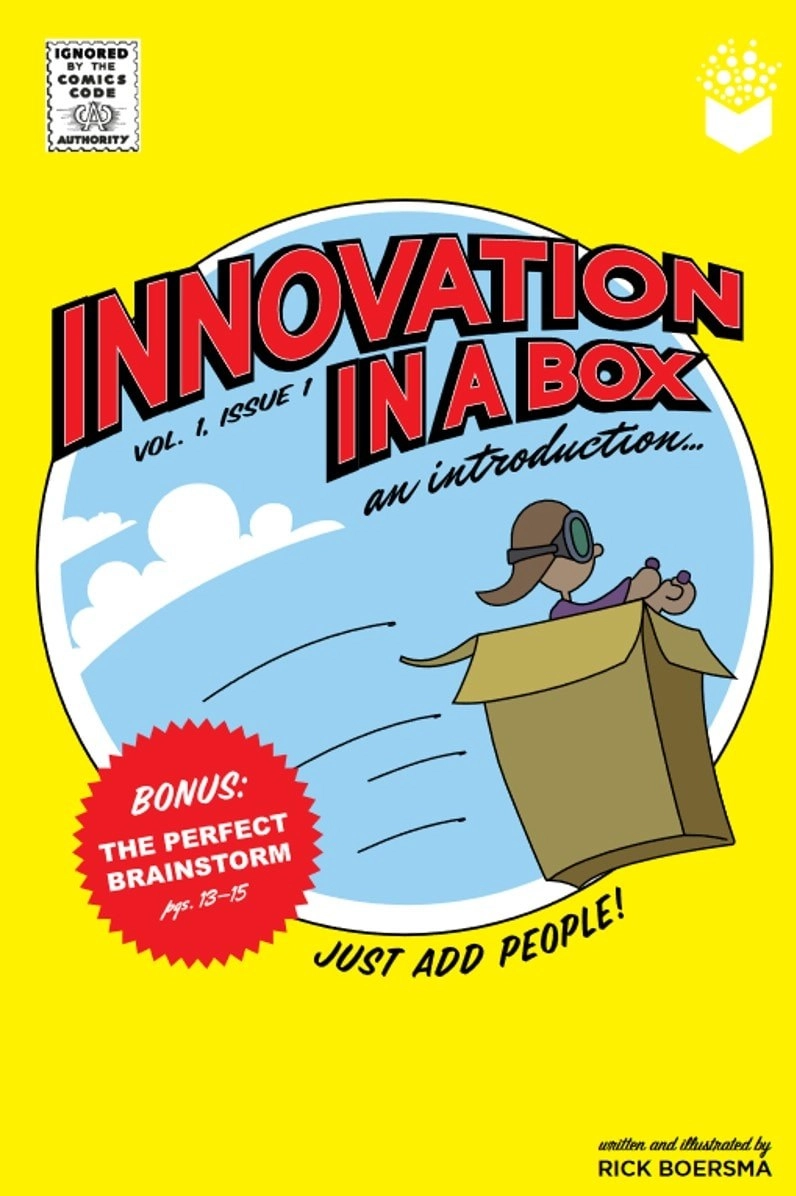
Innovation Made Simple: An Animated Introduction to the i5 Process and Tools
Powerful Ideas to Fuel Everyday Innovation
You know that old cliche that says you need to think out of the box to generate breakthrough solutions? Well, the evidence suggests otherwise. Research shows that the use of a structured innovation process allows an average group to produce 500% more useful ideas than a so-called creative group using conventional brainstorming. That’s why we built Innovation in a Box – a structured innovation process powered by practical tools that makes it easy for you to enable everyday innovation across your organization.
Introducing the i5 process and tools
It’s not enough to say “Think outside the box!”. If we expect people to think outside of their boxes, we need to provide them with a new box (or boxes) that provide the support they need to effectively engage with innovation. That’s where the structured i5 process and tools comes in. Watch the video and explore how Innovation In a Box can help you fuel every day innovation within your organization.

Illustrated Guide
An Introduction to the i5 Process and Innovation Tools
People have a tendency to freely swap the terms problem solving and innovation. But they’re not the same. Problem solving is reactive while Innovation is proactive. And while problem solving is necessary for survival, all it really does is maintain the status quo. True innovation is future focused and transcends the status quo.
Start your journey with fueling every day innovation with this graphically rich introduction to innovation, the i5 process and the practical tools that will help you and your team deliver breakthrough ideas.
Transcript
True innovation changes lives and fortunes
We live in a world characterized by complexity and change. Change can be political, economic, environmental. It can be social, measured in individual behaviors, or broad demographic trends. Change is also driven by science and technology, evidenced in the flood of discoveries in physics, computing in the life sciences that are constantly transforming our lives. And we’re compelled to respond, but are we really responding with innovation?
People have a tendency to freely swap the terms problem solving and innovation. But they’re not the same thing. Problem solving is reactive: You see the problem, it requires action and you fire-fight. Innovation is proactive.
And while problem solving is necessary for survival and staying competitive. All it really does is maintain the status quo. It’s easy to mistake this for innovation. But you don’t actually get ahead of the curve when you’re problem solving.
True innovation changes lives and fortunes. It’s future focused, it’s opportunity seeking, it transcends the status quo. It’s about leading instead of playing catch up.
Yet, while change is pushing us and the clear payoffs for real innovation should be exerting a powerful pull, breakthrough thinking is still rare. And the reason is simple:
Most people just don’t have a clue what thinking out of the box actually means.
And whether we use those exact words or not. What is clear is we cast folks adrift. Now, I think we know better.
What’s the number one thing employees need from their supervisors to ensure engagement and effectiveness? Clarity.
But clarity is absent from most innovation. And it gets worse – the lack of clarity, plus the pressure of creativity on demand, triggers a fight or flight response. Innovation requires openness and a flow of ideas. Instead, we push our people – and they push back or they simply shut down.
It’s not enough to say “Think differently!”. If we expect people to think outside of their boxes, we need to provide them with a new box that gives them the support they need to be engaged and effective.
People & Process: Key To Achieving a 500% Increase in Useful Ideas
We know there are five attributes of highly creative individuals. In an unstructured environment, someone who is highly creative will produce a lot of ideas, a wide range of ideas, original ideas, and they elaborate the grow and strengthen the ideas. And underpinning those four is openness, which is a willingness and ability to consider and risk those original ideas.
But you might say “I’m not especially creative, I’m just average”. Well, even if we’re not creative geniuses, we can still leverage that research. We can’t change our wiring. But there are two ways of increasing our creative output. To achieve that 500% increase that I mentioned earlier: through people and process.
By people, we mean creating an innovation Dream Team. I’m no Da Vinci, but I can increase the number of ideas I produce by increasing the number of people on my innovation team. And if I want to increase the range of ideas, I’ll increase the range or diversity of the people on that team. And finally, if I want to increase the originality of the ideas that I’m generating, I’ll enlist unique personalities who bring original perspectives.
4-Quadrant Model For Powerful Innovation Teams
We use a four quadrant model to describe and build well rounded innovation teams, each of the quadrants is a box representing a different way of thinking and innovating. A balanced team will have people who are:
Analytical and logical: They’ll be good at investigation.
Big picture thinkers: They’ll be excited by and good at generating lots of ideas, what we call ideation.
“People people”: They’ll be focused on the impact of the team solutions, especially on customers.
Implementers: They’re going to be organized and disciplined planners and project managers. Without them, our best ideas will probably never be delivered.
A dream team can effectively think out of the box because it has all the boxes covered, and each member gets to operate in their box exploiting their strengths.
i5 Process: Tools For Productive Innovation
But you ask, “What if my team, as nice as they are, isn’t a dream team?”. What if we’re all implementers or all ideators, or what if you don’t even have a team, but are left to innovate on your own? This is where the i5 Process comes in. The five stages of the i5 Process mirror the boxes in our thinking preferences model, and each box contains tools that make “out of the box thinkers” engaged and productive.
- Identification tools to help you identify the right problem
- Investigation tools for seeing the big picture and drilling down to root cause
- Ideation tools for generating and strengthening a wide range of original ideas
- Impact tools to decide which ideas are the best ideas
- Implementation tools to bring the best ideas to life
Instead of asking you to think out of the box, we’re going to help you step into a different box. In that box, you have clarity around goals, process and actions. For example, let’s say you’re a strong implementer, who has been told to be more creative. Rather than just handing you a marker and a flip chart and expecting you to free associate your way to a breakthrough, we’ll give you some simple time tested methods that will help you generate a wider range of original ideas. Some will be comfortable like value chain analysis, while others might stretch you a bit, like stimulus-response. But they all give you a structured method, a new box, that will make you more effective and help you feel grounded.
And it works no matter what your original boxes are. Asking a strong creative like me to manage a project is asking me to think outside of my box. And I know from experience that although I may never be a natural at it, I can pull it off. In fact, I can do it well using implementation tools like Gantt charts & prototyping.
Your content is only one click away.
Thanks for your interest in our content. We hope you find value in the time you invest with it. Click the button below and get immediate access to this truly valuable content.
Complete the form below and get instant access to this game-changing content.
Rest assured, we take your privacy seriously and will never sell, trade, or share your information with a third party.




